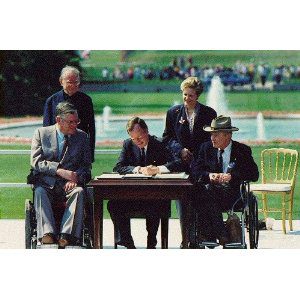
Signing of ADA into Law
The Americans with Disabilities Act (ADA) has its 20th anniversary on July 26, 2010. This ground-breaking civil rights law was intended to “establish a clear and comprehensive prohibition of discrimination on the basis of disability”. This protection is intended to be similar to that afforded Americans on the basis of race, religion, sex, national origin and other characteristics through the Civil Rights Act of 1964. Disability is defined by the ADA as “a physical or mental impairment that substantially limits a major life activity.” The determination of whether any particular condition is considered a disability is made on a case by case basis. Certain specific conditions are excluded as disabilities, such as current substance abuse and visual impairment which is correctable by prescription lenses.
So, after 20 years, has the ADA made a difference? For this writer, it has! The ADA prohibits discrimination in employment, in communication access, programs and services in state and local government and access to community (public) accommodations. All of these are evidenced in my personal life.
I grew up, a wheelchair user from my elementary school years, in a small town in the 1960’s and ‘70’s. There were no curb cuts on street corners. No accessible parking spaces at the nearby shopping locations although there were hand controls and other devices to modify your car to accommodate a disabled driver. When I learned to drive, I had to find that rare extra-wide parking spot to allow me space to park and get my wheelchair out of my car. It was rare that I could plan on a trip to the bathroom at a restaurant (without a parent helping to carry me in the bathroom). I learned to plan bathroom trips carefully, always “go before you go out”, and to plan lots of extra time getting to a location because I might not be able to park.
Now, my daughter is growing up in a very different world. She is also a wheelchair user but as a young teen, hasn’t known a world where she was limited by physical barriers in her community. She walks down to our neighborhood center with her friends, getting a push when the hills are steep, but not limited by curbs. Curb ramps abound in our neighborhood! She assumes I can park our modified van in an accessible parking space at any store, movie theater, school, mall, airport or park that she wants to visit. She was shocked to find, to her dismay, that not every restaurant has a fully accessible restroom when 90% of our community restaurants are available to us (see, Mom is still right to say, “go before you go out!”)
She sees adults with disabilities in nearly every work position she encounters. We know successful business professionals, folks in the medical and business fields, science and education. She has role models in a wide variety of occupations – as a “wheelchair girl”, she knows she can do whatever she wants for a job in the future (well, she did check flight attendant off her list as she finally acknowledged that she couldn’t get down the aisle with the drink cart successfully. But that’s only one of MANY, many jobs out there!) And discrimination in employment is just one of the many barriers that the ADA is helping to break down.
She is still too young to notice the third benefit that I use frequently – access to communication. My hearing is declining rapidly as a part of my disability and while my hearing aids help immensely, I still struggle at lectures or the theater. I have become quite saavy about getting assistive listening devices at the symphony, lectures, theater or any time I can’t seem to catch what is being said. This is still a great job to me – that I can do things with friends out in the community and be a part of it all.
I wonder, at times, if all this benefit, invisible to her since she has known nothing else, will go uncelebrated. Accessing my community independently still brings me intense pleasure, in part, because I cherish what I worked hard to obtain. Will our young people still hold it community access dear? There is still work to be done – our civil rights can still be removed or reduced. The ADA allows a community of people to be contributing members of our society – but we can do more! Many people with disabilities are waiting for job opportunities, to allow them to get involved, to contribute, to pay taxes. The ADA has made a change in our physical community, now we just need to change our attitudes along with it.
Happy 20th Anniversary, ADA! I am looking forward to the next 20 years of change.
Leave A Comment